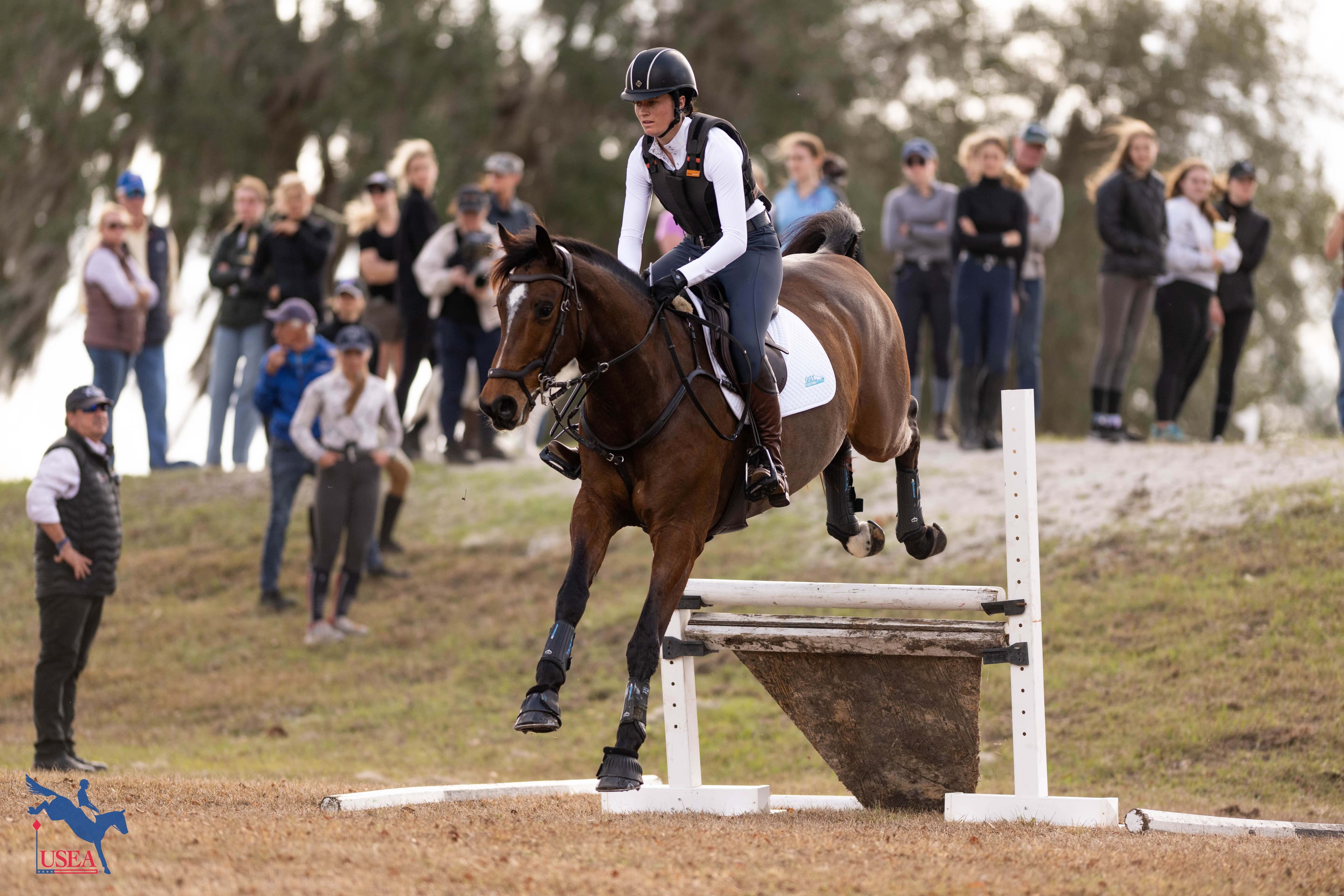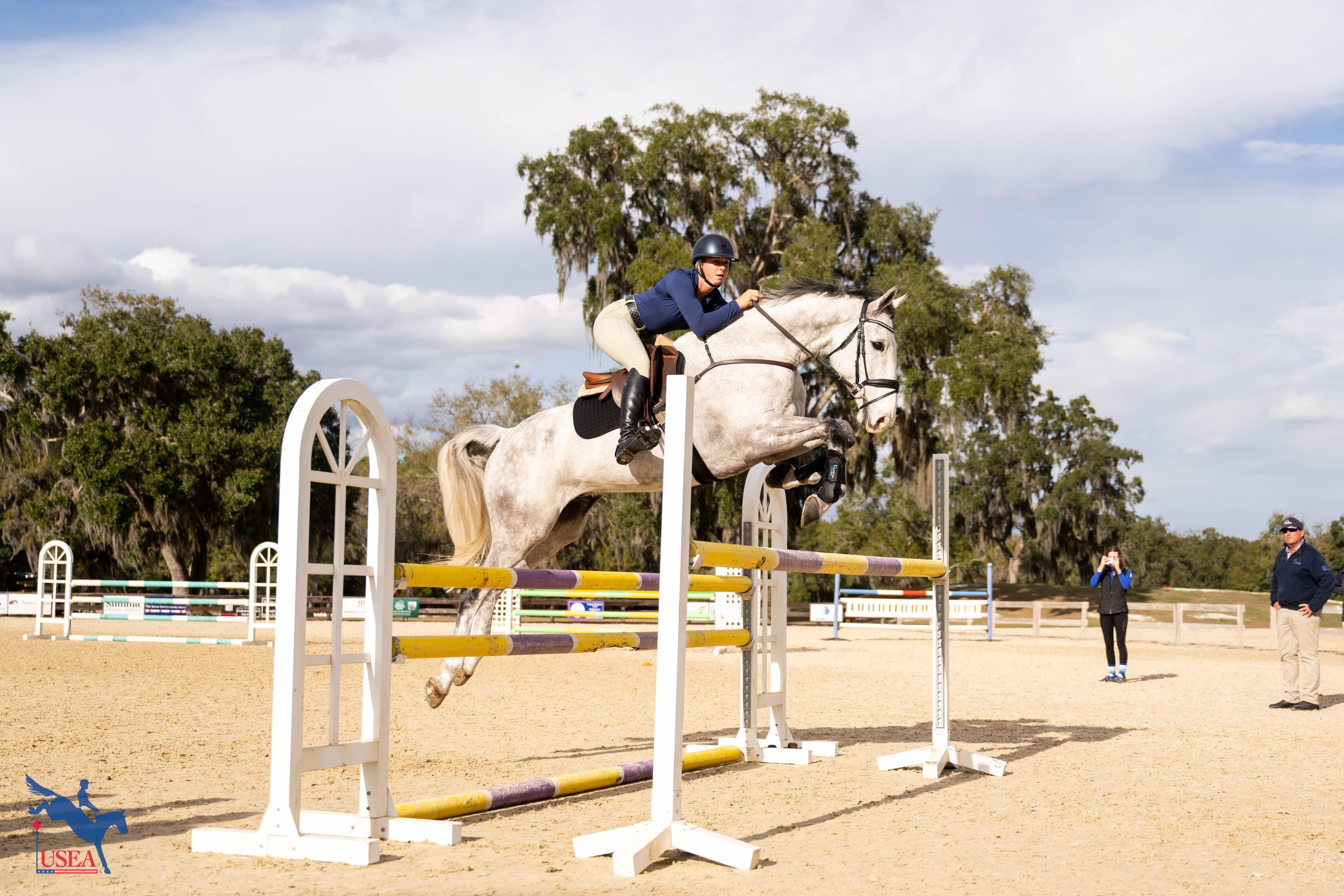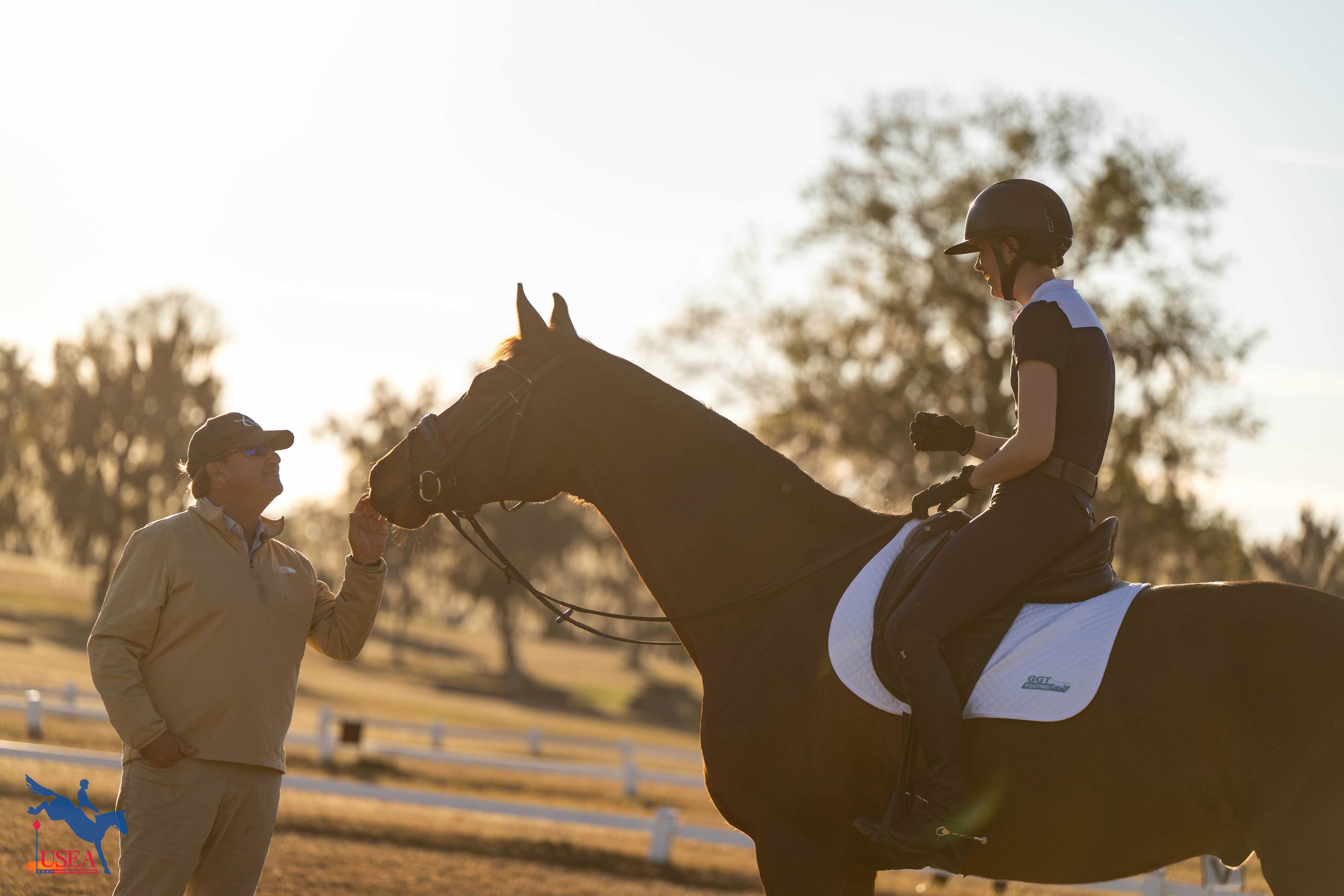Grid Pro Quo with Robert Costello
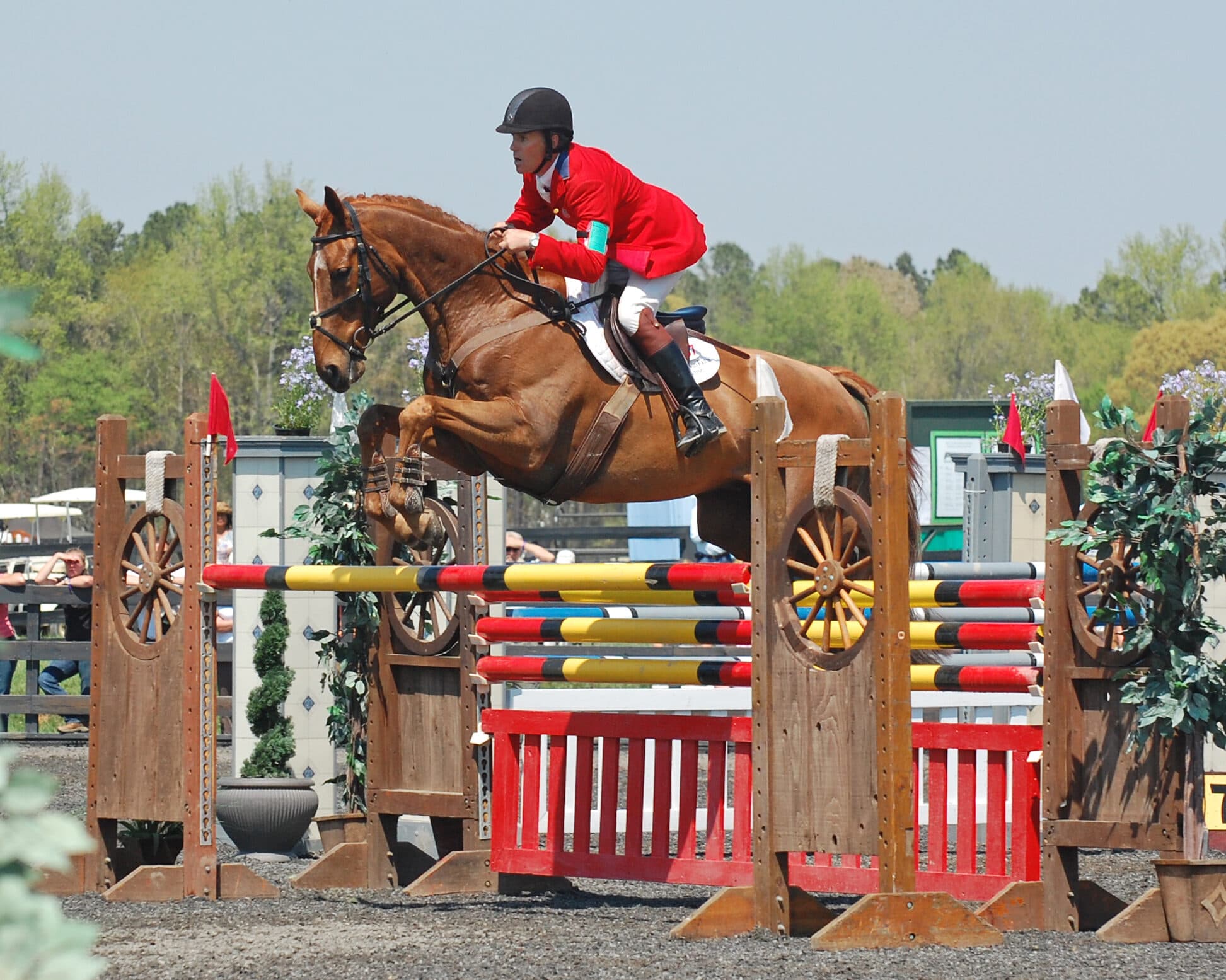
Don't let the winter weather get you down when you can use being stuck in the arena as an opportunity to fine tune your riding! In this series, we are reviving past Grid Pro Quo articles from Eventing USA to help you use the off-season to your advantage and keep you and your horse in tip-top shape for when it's time to get back out there. Click here to check out other past Grid Pro Quo exercises to spice up your arena this winter!
There comes a point in both a rider’s and a horse’s training when the cantering of grids should become part of the repertoire. Practicing the cantering of grids only makes sense as ultimately a grid is a combination, and we do not trot combinations in competition.
Why:
How often do we see a rider executing a lovely show jumping round only to have it all come apart at the first combination? I see this none-to-rare occurrence play out time and again as I travel about giving clinics as well as the lessons I teach at home. We need to condition ourselves to understand that riding into a combination really just requires good rhythm and balance on a straight line to a single jump. If we can achieve that, then we have done our job; the rest is up to the horse. Of course, this is easier said than done, so like anything else it demands practice, practice, practice. Just think of the cantering part of this exercise as an added benefit to what a well-designed grid should accomplish.
For the horse, this grid will test and ultimately improve straightness, balance, control, agility, rideability, and form over fences.
For the rider, this grid will test and ultimately improve control, concentration, position, effective use of aids, and plan execution.
The slightly shorter distances will encourage your horse to jump “around” the fences, creating the desired bascule in the air as opposed to “at” the fences, which results in a flat and often careless jump. This is not a one-size-fits-all exercise and can be modified to suit your particular horse as long as it stays ultimately challenging.
This grid is a bit more on the advanced side but should be well within the capabilities for the Novice level horse and/or rider and above. It is a grid I have played around with and developed over a period time. Those that have ridden in clinics with me will recognize at least parts of this exercise. For greener horses and riders, the grid can initially be approached in trot. Simply shorten the distance between the first two elements to 17 or 18 feet.
How:
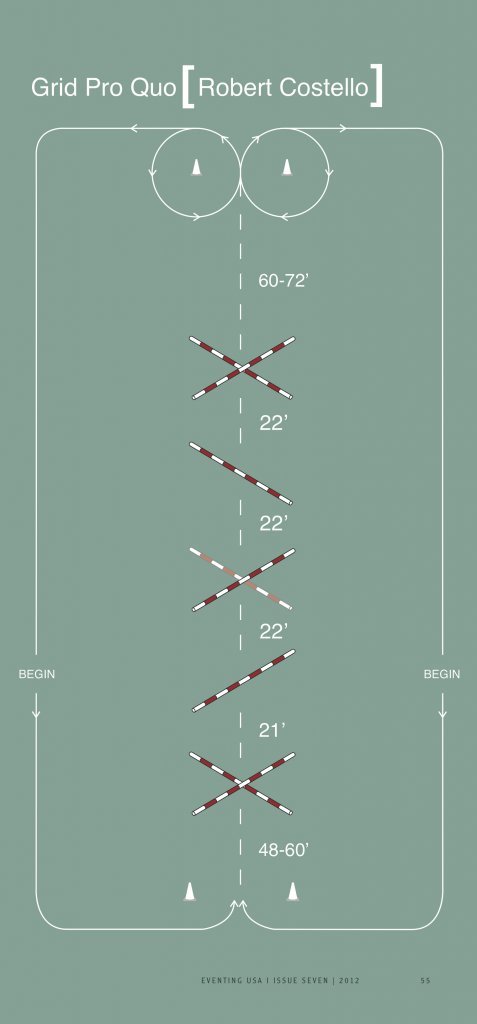
Set up cones at least 4 to 5 strides (48-60’) before the first set of standards and at least 5 to 6 strides (60’-72’) after the last set. As part of your warmup and beginning on the left rein, practice riding the pattern of the exercise first in trot. Pay special attention to the quality of your turn through the first set of cones, the straightness of the trot through the empty standards, and the quality of your right turn (light off the inside leg, connected to the outside rein, not leaning in nor bulging out) and subsequent 15-meter circle around the cone. Proceed down the long side of the arena and repeat the exercise a few times, alternating the direction each time.
The use of the cones and the 15-meter circles are to aid the rider in executing a quality turn, a perfectly straight approach to and out of the grid, and finally a well-balanced, rider-initiated turn after the exercise. This is a great exercise for horses who tend to “cut” the turn or for their riders who let them.
Practice the same pattern in canter, starting on the left lead. This will be the same exact pattern you will use when the jumps are added. Turn left through the cones and continue absolutely straight through the empty standards. Well back from the second set of cones, transition to trot and establish the new bend as you track right and canter on the 15-meter circle. Proceed down the long side of the arena and repeat the exercise (tracking left the next time, and so on) until you can perform the pattern seamlessly and in balance.
Slowly add the jumps starting at a height that you and your horse are both comfortable (hopefully at least 2’6”). As you feel your horse become more balanced through the turns the 15-meter circle can be omitted, though you will continue alternating the direction as described above. As you add jumps, the cones at the end of the arena will come up more quickly, requiring a quicker— though hopefully still smooth—response from you, the navigator.
The first element will be a simple giant X. It will look imposing, though in reality may only be 2’6” in height in the middle.
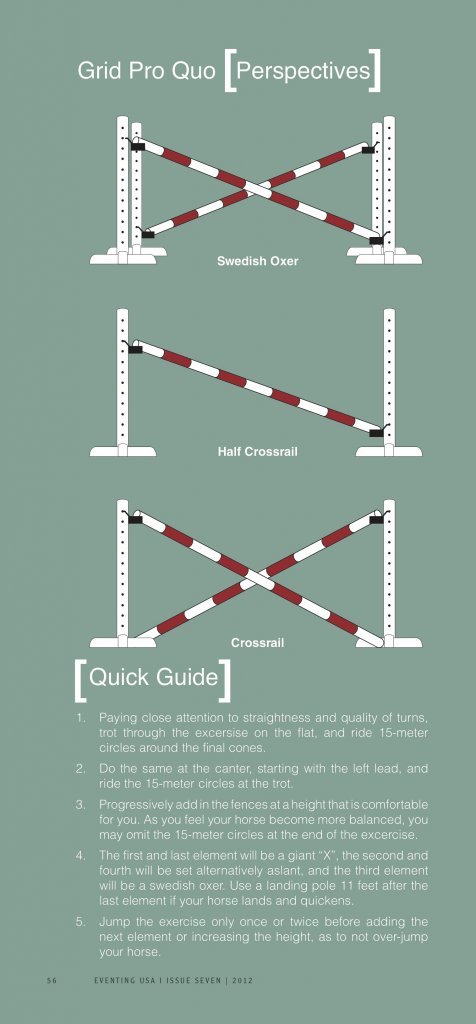
It will have the effect of “holding” your horse’s attention to the center of the first jump. For elements two, three, and four the rail will purposely be set alternatively aslant. As is similar with the giant X this will aid in keeping the horse straight. It will also be a visual aid for you as the rider to keep your horse straight. If your horse tends to drift right, elements two and four will be three holes higher on the right, and vice-versa if your horse tends to drift left. [Note: The height of the jumps should always be measured in the middle of the rail].
Element three will essentially be a Swedish oxer, and element five will be another giant X. A landing pole set 11 feet after the final element can be used if your horse tends to land and quicken.
So as not to over jump your horse, only jump the exercise once or twice before adding the next element and/or increasing the height. Keep all the heights fairly identical (taking the measurement in the center of the slanted rails and giant X), much like it would be in a combination in competition. The height of the exercise should be considered secondary to the aforementioned successful execution.
Overall Advice
- Grids are an opportune time to practice perfect position. The make-up of this grid should do a lot of the work for you, so you should therefore be thinking: Weight in the heels, quiet upper body, flat back, chin up, and stable and consistent release in the air.
- Overall there should be very little movement on your part in the air. Let your horse do the jumping.
- Practicing grids without focusing on straightness will dramatically reduce the intended positive effect of the exercise. Challenge yourself and your horse to approach, take flight, cruise through the air, and land and depart from the grid on the same line. Imagine as you complete your turn through the first set of cones that a train track has been laid down right through the middle of the grid and that your aids (legs, opening, leading or guiding rein, eyes, etc.) are what keep it all on the rails. Your horse will never truly maximize his jumping potential if he is not straight.
- Do not be tempted to lengthen the distance in the exercise simply because your horse gets a little quick and finds it tight. Stick with your plan, stay soft, and let the jump do the “dirty work” for you. If he rubs a jump with no help from you he will come back the next time and take notice. If you ride the hand break through the exercise and he still rubs a jump, most likely he will not have learned much. Just like humans, a horse will learn from his mistakes if allowed to do so on his own.
- This exercise need not be completed in just one session. If you feel you need time just to conquer the pattern without the added pressure of jumps, come back to it the next time. Keep in mind that gridwork should essentially be stress free as long as it is approached logically and systematically.
- Above all else, keep it fun and enjoy the challenge this grid presents.
About Robert Costello
ROC Equestrian is based at Winter Book Farm in Southern Pines, North Carolina, where Robert Costello offers a clear, systematic, and no-nonsense training approach for both horses and riders. He is a USEA ICP Certified Level IV Instructor and represented the United States at the 2000 Sydney Olympic Games with Chevalier and at the 2003 Pan American Games with Dalliance. In addition to keeping an active teaching and clinic schedule, Robert has held many volunteer leadership positions, including sitting on the boards of the boards of the USET, USEA and USEF, serving as Chairman of the USEF Active Athletes Committee, USEF Eventing High Performance Committee, and USEF Eventing Selection Committee for Olympic, World and Pan American Games. In 2014, Robert was honored by the USEA for a lifetime of service by being awarded the prestigious Wofford Cup.
This Grid Pro Quo first appeared in Volume 42, Issue 7 of Eventing USA.

